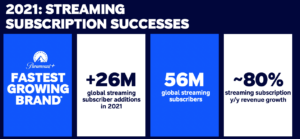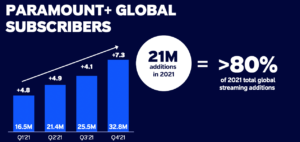
[ad_1]
Published on July 11th, 2022 by Felix Martinez
Berkshire Hathaway (BRK.B) has an equity investment portfolio worth more than $360 billion as of the end of the 2022 first quarter.
Berkshire Hathaway’s portfolio is filled with quality stocks. You can ‘cheat’ from Warren Buffett stocks to find picks for your portfolio. That’s because Buffett (and other institutional investors) are required to periodically show their holdings in a 13F Filing.
You can see all Warren Buffett stocks (along with relevant financial metrics like dividend yields and price-to-earnings ratios) by clicking on the link below:
Note: 13F filing performance is different than fund performance. See how we calculate 13F filing performance here.
As of March 31, 2022, Buffett’s Berkshire Hathaway owned just over 68.9 million shares of Paramount Global (PARA) for a total market value exceeding $1.67 billion. Paramount Global currently constitutes over 0.5% of Berkshire Hathaway’s investment portfolio.
This article will thoroughly examine Paramount Global’s prospects as an investment today.
Business Overview
ViacomCBS Inc., now called Paramount Global, is an American multinational media conglomerate based in New York City. The corporation was formed via the re-merger of CBS Corporation and Viacom on December 4, 2019, the two created from the split of the original Viacom in 2005. The company’s content brands include CBS, Showtime Networks, Paramount Pictures, Nickelodeon, MTV, Comedy Central, BET, and CBS All Access.
The company has six revenue segments, where Advertising, Affiliate, and Content Licensing are the most significant revenue sources. Paramount is an $18.2 billion market capitalization company that generated more than $28.5 billion in revenue for 2021.
The company reported first-quarter results for Fiscal Year (FY)2022 on May 3, 2022. The company reported revenues of $7,328 million for the quarter vs. $7,412 million in 1Q21, or a 1% decrease year-over-year. This was due to the TV Media segment seeing a reduction in revenue of 6% year-over-year. The operating income reported was $775 million for the quarter, a significant decrease of 49% compared to the $1,528 million the company reported in 1Q21. The company added 6.8 million global streaming subscribers, overwhelmingly led by Paramount+.
PARA has reached over 62 million subscribers in the quarter and achieved 95% year-over-year growth in streaming subscription revenue. The advertising segment saw a revenue increase of 59% for the quarter. This was due to Pluto TV and Paramount+ growth driven by increased pricing and impressions on both services. Non-GAAP EPS of $0.60 was reported, decreasing by 61% compared to $1.52 per share reported in the first quarter of 2021.
Consensus estimates expect the company’s earnings-per-share to be $2.60 for FY2022. This will be a decrease of 25.3% compared to FY2021. We will use the FY2022 estimate of $2.60 for our valuation calculation.
Source: Investor Presentation
Growth Prospects
Over the last decade, Paramount had an earnings compound annual growth rate (CAGR) of 3.5% and a negative 10.0% CAGR over the past five years. With Viacom and CBS’s merger completed, the company is one of the most significant content producers and providers globally. This allows Paramount to be in a solid position as content demand continues to grow.
We estimate a five-year expected growth rate of 2% as management continues to integrate both companies. The net Margin increased for FY2021 to 15.9%, compared to an FY2020 net margin of 9.6%. The company had to freeze its dividend during 2018 preparing for this merger. Before that, it had a 5-year dividend growth of 7.6%. We expected the company to start to grow its dividend at a growth rate of 2% over the next five years.

Source: Investor Presentation
another growth driver would be, of course, the growth of the company Paramount+ subscribers. As you can see, the company has been growing its subscriber base nicely.

Source: Investor Presentation
Competitive Advantages & Recession Performance
Paramount’s competitive advantage is its valuable content, such as the ones mentioned in the Overview section, and being in a great position to be one of the largest producers of new content in the future. However, this company is not recession resilient as its services and products are a luxury. During the Great recession of 2008-2009, the company’s share price lost 83.7%) from peak to trough. The company also cut its dividend from $1.06 per share to $0.20 per share, an 81.1% dividend cut.
However, the current dividend payout ratio is low, at only 37%, based on FY2022 earnings. Consensus estimates that free cash flow (FCF) for FY2022 will be $1.09 per share, which gives a dividend payout ratio of 88.5% based on FCF. The company currently has a debt-to-equity ratio (D/E) of 0.9, which is good. The company also sports a credit rating of BBB.
Another competitive advantage that the company has is its brands of shows.

Source: Investor Presentation
Valuation & Expected Returns
Over the past decade, Paramount shares have traded with an average P/E of 13.2. However, over the past five years, it has averaged a P/E of 9.6. Given current headwinds, we will use a P/E of 10 for our fair value estimate. This represents a (1.1)% downside as the current P/E of PARA is 10.6 based on the 2022 EPS estimate of $2.60 per share.
Another valuation metric to look for is the company dividend yield average history. The current dividend yield is 3.8%, compared to the company five year average of 2.2%. As you can see, based on the dividend yield, the company looks to be undervalued.
Final Thoughts
Paramount offers a low projected total return. as mentioned above, we forecast 4.3% annualized returns for the next five years as the moderate growth and overvaluation make Paramount unattractive at current prices. Thus, we rate PARA as a Hold.
Other Dividend Lists
Value investing is a valuable process to combine with dividend investing. The following lists contain many more high-quality dividend stocks:
Thanks for reading this article. Please send any feedback, corrections, or questions to [email protected].
[ad_2]
Source link